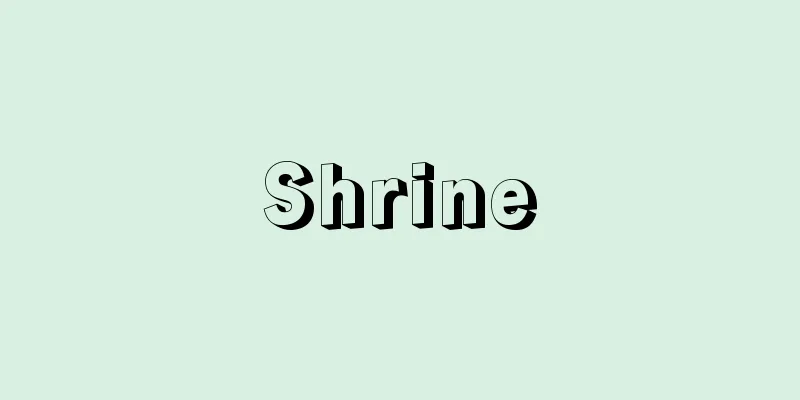Shrine

|
Based on the unique Japanese ethnic beliefs, this refers to buildings (such as a worship hall, main hall, and offering hall) with a certain style for worshiping gods (Gods of Heaven and Earth, ancestors, revered deities, the Emperor, the Imperial Family, and other human spirits), as well as the rituals and religious organizations centered around them. The pioneering form of shrines is thought to have been a sacred place such as an iwakura or iwasaka, where a sacred tree was set up to worship the gods. Rites were performed by clan elders, duty officers, and other leaders, and centered on spring prayers for a good harvest and autumn harvest thanksgiving festivals. In the past, local groups and blood relatives were closely related, so clan deities and tutelary deities were the central objects of worship, and when the ritual sites also became the village meeting places, specialized priests and permanent shrine buildings were built. During the process of unification by the Yamato Imperial Court, shrines that existed in various places were also reorganized and consolidated. Under the Ritsuryo system, the Jingikan was placed under the Daijokan, and a distinction was made between kan and kokuheisha, and large and small shrines; these are detailed in the Engishiki. In the Heian period, the imperial court bestowed ranks on each shrine. In the mid-Heian period, large shrines in the Kinai region began to receive special treatment, and were called Kinaisha, as opposed to shikinaisha. In response to this, in local areas, representative shrines were designated as ichinomiya, and sosha (main shrines) were enshrined near provincial capitals. In the Kamakura period, shrines were given special protection by the shogunate, and worship of Hachiman-gu, a war god, began to emerge. In the Edo period, they came under the control of the Jisha Bugyo. During the Meiji Restoration, shrines were deemed the "main shrines of the nation," and Shinto priests became government officials or equivalent, and shrine ranks such as kan and kokuheisha, prefecture, village and village shrines were established, but these were abolished after the war. →Shrine architecture/Shrine Shinto→Related topics: Shrines Source : Heibonsha Encyclopedia About MyPedia Information |
|
日本固有の民族的信仰に基づき,神(天神地祇(ちぎ),祖神,崇敬神,天皇,皇族,その他の人霊)をまつる一定の様式をもった建築物(拝殿,本殿,幣殿など)と,それを中心とする祭祀儀礼,信仰の組織をいう。 神社の先駆的な形態は磐座,磐境(いわさか)のような神聖な場所に神籬(ひもろぎ)を設けて神をまつったものと考えられる。祭祀は氏族の長老・当番・その他の指導者によって行われ,春の豊年祈念と秋の収穫感謝の祭が中心であった。古くは地域集団と血族集団の関係が密接であったので,氏神と産土(うぶすな)神などが崇拝の中心的対象であり,その祭場が集落の集会場ともなるに及んで,専門の司祭者や常設の社殿が建てられるようになった。 大和朝廷の統一の過程で,各地にあった神社も整理統合されていった。律令制下では太政官の下に神祇官を置き,官・国幣社と大・小社の区別が定まり,これらは延喜式に詳しい。平安時代には朝廷は各社に位階を授けた。平安中期には畿内での大きな神社が,特殊な扱いを受けるようになり,式内社に対して畿内社と呼ばれた。これに対し,地方では代表的神社を一宮とし,また国府の近くに惣社(総社)を勧請した。 鎌倉時代には神社は幕府によって特別の保護を加えられ,武神とされる八幡宮の信仰が起こった。江戸時代には寺社奉行の支配下に入った。明治維新では〈国家の宗祀〉とされ,神職は官吏もしくはそれに準じることとなり,官・国幣社,県・村・郷社などの社格が定められたが,戦後廃止された。→神社建築/神社神道 →関連項目社 出典 株式会社平凡社百科事典マイペディアについて 情報 |
Recommend
Cupboard - Todana
A general term for storage equipment with a door ...
Aulona
...Population: 74,000 (1990). Founded in the 2nd ...
Tadami [town] - Tadami
A town in Minamiaizu County in western Fukushima P...
Narcotic
Narcotics is a general term for a series of drugs...
Bethlehem Steel Corp.
The second largest integrated steel manufacturer i...
Marl (English spelling)
Marl, as it is commonly used today to describe sed...
Day tank (English spelling)
...This involves replacing damaged firebricks, an...
Thermal radiation
In addition to reflecting, absorbing, and transmi...
Otago (English spelling)
This region lies in the southeast of the South Isl...
Killer whale (orchid)
A mammal of the family Delphinidae in the suborder...
katharevousa
… After the collapse of the Roman Empire, Greek w...
Galway - Galway (English spelling)
The capital of County Galway in the west of the R...
Kaiseki Sada
A monk and nationalist in the early Meiji period....
Thread maker - Beloved
...The silk-reeling techniques at the time were v...
Madagascar jasmine
…Madagascar jasmine S. floribunda Brongn. is an e...









